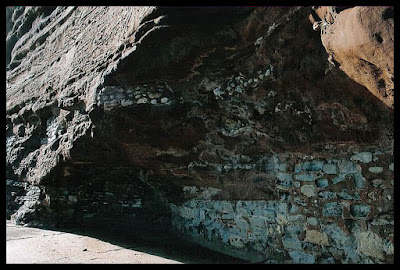Following on from the previous article about Jacob's Ladder Beach and Connaught Gardens, I wanted to do a more in-depth write-up about the walkway and an opportunity to encompass the huge amount of photos I'd taken. The abandoned boat on the beach is where we left off last time so that's where we'll start. :)
Clifton Place, comprising several buildings, can be seen on the road above at the start of the walk. As
noted in the last article, there are several different components to
the cliffs, including parts of bricked walls, flint and pebblestones, as
well as the sandstone bedrock, which all makes for some very
interesting colours and textures.
It also includes this interesting little culvert. Most of the original outlet has been bricked in, leaving a circular tunnel for a small stream coming through the cliffs.
And a set of steps up to the rear of the above cottages; presumably to one of their gardens.
I'm planning to write a separate article about Clifton Place and its lovely, quirky cottages, so this is just a taster at the moment. Meanwhile, we get onto the walkway around the base of the cliffs.
The
area with railings above the cliff (seen above and below) is part of Connaught
Gardens and a great place for a view over the town of Sidmouth.
Looking back towards this piece of cliff rock, below. It might sound a bit weird but the shape of it always reminds me of the evil baddy in a 1981 Sci-fi film called Tron. I'm not dangerous, honest! ;)
Beyond that can be seen the red Mercian Sandstone cliff at the opposite end of Sidmouth. The 220 million year red sandstone rocks date back to the Triassic period and can be seen along most of the East Devon and South Devon coastlines, at one time colloquially known as Red Devon.
This stretch here is also a red sandstone but is different to the Mercian (also known as Red Marl) and is called Otter Sandstone. This walkway part lies between two faults, which differentiates the two types of sandstone, the Mercian / Red Marl once again evident along Jacob's Ladder beach.
When I first walked around the base of the cliff I was totally amazed at the formation of the cliffs through erosion, the brick & pebble patching, and sgraffiti scratched into the soft sandstone, all subsequently weathered into lovely shapes and patterns. I've visited twice and both times were totally enchanting.
The fantastical shapes of the rock formations have a wonderfully organic look about them.
Normally I'm not keen on graffiti, but the sgraffito carvings are utterly delightful here, more so as they soften and become part of the rock decor. The rock face below has an almost Aztec style in its lettering and patterns caused by weathering.
There are the usual hearts dotted about...
...including one in the sand on the beach, although a bit difficult to see from this angle...
...some rather nice artistic lettering...
...and one lovely smiley face. :)
I've also included another look at where the lime kilns once stood at the end of the cliffs. Once demolished the site was made into a tower, strengthened by flint rendering, with the top made into a castellated boat house..the whole edifice made to look like a castle.
There were once many lime kilns along the coast of East Devon & West Dorset, particularly because limestone was shipped by sea in coastal areas and off-loaded near to the kilns. Used originally only for building purposes, such as the production of cement, brickmaking and limewash, lime was later found to be beneficial in small quantities as a soil improver and produced for farming. Although very few now remain, small kilns can be still be seen at Budleigh Salterton, and also one at Charmouth in Dorset, which produced lime to be used at the nearby cement factory. None are in use today.
I'd
read about the Sidmouth kilns with an early print of when they
were in use, and often wondered where they were and if
there were any remains. Then I came across a geology website which
mentioned that they were on the edge of Connaught Gardens and now used
as a cafe / restaurant. Hidden in plain sight! ;)
Parts of the old winch for the erstwhile boathouse, seen in the photos above, which also show the cliff side where there's a small takeaway & shop.
And below, some lovely pebbly, bricky, rusty seaside goodness. ;)
And finally, because I only put a few photos of the erstwhile boathouse that's now a cafe/restaurant in the previous article, I'm adding the others along with those again.
As noted in the first post, and also in my article about pebble buildings, this is absolutely covered in pebbles.
Plus there's the odd wall with flint, both materials widespread throughout the area in vernacular buildings.
And there we have it! A fascinating part of East Devon and one which I love taking photos of...evidenced by the amount I've put in these articles! ;)
By the way, I apologise for taking a while to get this finished and not posting anything for the last two months, but I wasn't too well then had a case of writer's block when I hardly managed to string two words together. Feeling much better now, and catching up with a lot of stuff, I was determined to get this in before we're into December tomorrow. More posts coming up soon.
Cheers. :)















































































No comments:
Post a Comment